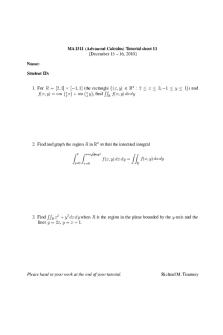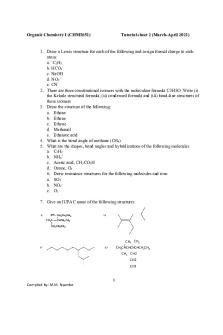MA1132 2015-2016 Tutorial Sheet 11 PDF

| Title | MA1132 2015-2016 Tutorial Sheet 11 |
|---|---|
| Course | Advanced Calculus |
| Institution | Trinity College Dublin University of Dublin |
| Pages | 2 |
| File Size | 62.5 KB |
| File Type | |
| Total Downloads | 35 |
| Total Views | 124 |
Summary
Download MA1132 2015-2016 Tutorial Sheet 11 PDF
Description
Module MA1132 (Frolov), Advanced Calculus Tutorial Sheet 11 To be solved during the tutorial session Thursday/Friday, 7/8 April 2016 Name: 1. Compute the integral Z In (A, B) =
∞
−∞
···
Z
∞
−∞
exp −
n X
xi Aij xj + 2
i,j=1
n X
Bi xi
i=1
!
dx1 · · · dxn ,
where A = (Aij ) is a positive-definite symmetric n × n matrix.
Solution: Let us introduce the column x with entries xi and the column B with entries Bi . Then we can write in matrix form n n X X Bi xi = −xt · A · x + 2B t · x , x A x + 2 − (1) i ij j i=1
i,j=1
where · denotes the matrix multiplication, and t denotes matrix transposition. Then using that At = A we can write (complete the square) −xt · A · x + 2B t · x = −(x − A−1 · B)t · A · (x − A−1 · B) + B t · A−1 · B = −y t · A · y + B t · A−1 · B ,
where y = x − A−1 · B. Thus, the integral In (A, B) is equal to Z ∞ Z ∞ t t −1 e−y ·A·y+B ·A ·B dy1 · · · dyn In (A, B) = ··· −∞ −∞ Z Z ∞ ∞ t t −1 e−y ·A·y dy1 · · · dyn . = eB ·A ·B ···
(2)
(3)
−∞
−∞
Since A is symmetric it can be diagonalised by an orthogonal matrix A = O · Λ · Ot ,
Λ = diag(λ1 , . . . , λn ) ,
Now, we make the following change of variables y = O·z
⇔
yi =
λi > 0 ∀i , n X
O : O · Ot = I .
Oij zj .
(4)
(5)
j=1
The Jacobian matrix is (∂yi /∂zj ) = Oij . Since O is orthogonal one gets J = det(∂yi /∂zj ) = ±1 . Thus the integral takes the form Z ∞ Z ∞ t t B t ·A−1 ·B e−y ·O··ΛO ·y dy1 · · · dyn In (A, B) = e ··· Z−∞ Z −∞ ∞ ∞ t t −1 e−z ··Λz dz1 · · · dzn = eB ·A ·B ··· Z−∞ Z −∞ ∞ ∞ Pn t −1 2 = eB ·A ·B ··· e− i=1 λiz i dz1 · · · dzn −∞ −∞ n t −1 B t ·A−1 ·B Z ∞ eB ·A ·B n/2 e −z 2 e dz π . =√ = √ λ1 · · · λn λ1 · · · λn −∞ 1
(6)
Since λ1 · · · λn = det A, we finally get In (A, B) = eB
t ·A−1 ·B
π n/2 . det A
(7)
2. Find the volume Vn,h of an n-simplex ∆ n ∆n :
x1 ≥ 0 , . . . , xn ≥ 0 ,
x1 + x2 + · · · + xn ≤ h .
(8)
Solution: From the definition of ∆n we get 0 ≤ xn ≤ h − x1 − x2 − · · · − xn−1 .
(9)
Thus, the projection of ∆n onto the hyperplane xn = 0 is the n − 1-simplex ∆n−1 , and Z h−x1 −···−xn−1 Z Z Z Z Vn,h = · · · dx1 · · · dxn = · · · dxn dx1 · · · dxn−1 . (10) ∆n
0
∆n−1
Repeating the procedure we get Z Z h Z h−x1 Vn,h = ··· 0
h−x1 −···−xn−1
(11)
dxn · · · dx2 dx1 .
0
0
Making the change x1 = hξ1 , x2 = hξ2 , . . . , xn = hξn ,
(12)
one gets n
Vn,h = h αn ,
αn ≡ Vn,1 =
Z 1 Z 0
1−ξ 1
···
0
Z
1−ξ 1 −···−ξ n−1 0
dξn · · · dξ2 dξ1 .
On the other hand comparing αn with (11), one sees that αn is equal to Z 1−ξ1 −···−ξn−1 Z 1 Z 1−ξ1 Z 1 ··· (Vn,1−ξ1 ) dξ1 αn = dξn · · · dξ2 dξ1 = 0 0 0 0 Z 1 αn−1 n−1 = αn−1 . (1 − ξ1 ) dξ1 = n 0
(13)
(14)
Taking into account that α1 = 1, one finds αn =
1 , n!
(15)
Vn,h =
hn . n!
(16)
and finally
2...
Similar Free PDFs

MA1132 2010-2011 Tutorial 11
- 1 Pages

Tutorial 11
- 2 Pages

Tutorial Sheet 1
- 2 Pages

Tutorial sheet 1 Solution
- 5 Pages

Tutorial Sheet 1
- 1 Pages

Tutorial 11 ans
- 2 Pages

Tutorial 11 - Answer
- 8 Pages

Tutorial 11 A
- 2 Pages

Tutorial preparation 11
- 2 Pages

Tutorial Week 11 - Test
- 9 Pages

EXPERT CHOICE 11 TUTORIAL
- 8 Pages

Week 11 Tutorial
- 4 Pages

Tutorial LAW299 (WEEK 11)
- 2 Pages
Popular Institutions
- Tinajero National High School - Annex
- Politeknik Caltex Riau
- Yokohama City University
- SGT University
- University of Al-Qadisiyah
- Divine Word College of Vigan
- Techniek College Rotterdam
- Universidade de Santiago
- Universiti Teknologi MARA Cawangan Johor Kampus Pasir Gudang
- Poltekkes Kemenkes Yogyakarta
- Baguio City National High School
- Colegio san marcos
- preparatoria uno
- Centro de Bachillerato Tecnológico Industrial y de Servicios No. 107
- Dalian Maritime University
- Quang Trung Secondary School
- Colegio Tecnológico en Informática
- Corporación Regional de Educación Superior
- Grupo CEDVA
- Dar Al Uloom University
- Centro de Estudios Preuniversitarios de la Universidad Nacional de Ingeniería
- 上智大学
- Aakash International School, Nuna Majara
- San Felipe Neri Catholic School
- Kang Chiao International School - New Taipei City
- Misamis Occidental National High School
- Institución Educativa Escuela Normal Juan Ladrilleros
- Kolehiyo ng Pantukan
- Batanes State College
- Instituto Continental
- Sekolah Menengah Kejuruan Kesehatan Kaltara (Tarakan)
- Colegio de La Inmaculada Concepcion - Cebu


